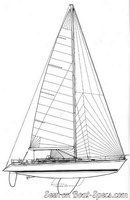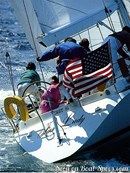First 51 S / Deep draft
Sailboat specifications
The First 51 is a 50’ (15.23m) cruiser-racer sailboat designed by Frers Naval Architecture & Engineering (Argentina). She was built since 1986 (and now discontinued) by Bénéteau (France). The S / Deep draft version offers a deeper keel, longer mast, and larger sail area.
The First 51 is as well listed, on Boat-Specs.com, in Wing keel version (see all the versions compared).
The First 51 is as well listed, on Boat-Specs.com, in Wing keel version (see all the versions compared).
First 51's main features
- Model
- First 51
- Version
- S / Deep draft
- Hull type
- Monohull
- Category
- Offshore cruiser-racer sailboat
- Sailboat builder
- Sailboat designer
- Sailboat range
- Country
- France
- Construction
- GRP (glass reinforced polyester):
- Hull: Single skin fiberglass polyester
- Deck: Sandwich balsa fiberglass polyester - First built hull
- 1986
- Last built hull
- Discontinued
- Appendages
- Keel : fin without bulb
- Helm
- Twin helm wheels
- Rudder
- Single spade rudder
- Unsinkable
- No
- Trailerable
- No
- Former French navigation category
- 1
- Standard public price ex. VAT (indicative only)
- N/A €
First 51's main dimensions
- Overall length
- 51’ 4”15.63 m
- Hull length
- 50’15.23 m
- Waterline length
- 43’ 1”13.15 m
- Beam (width)
- 14’ 11”4.55 m
- Waterline beam (width)
- 12’ 1”3.7 m
- Draft
- 9’ 2”2.8 m
- Mast height from DWL
- 77’ 10”23.7 m
- Light displacement (MLC)
- 28660 lb13000 kg
- Ballast weight
- 14220 lb6450 kg
- Ballast type
- Lead
First 51's rig and sails
- Upwind sail area
- 1652 ft²153.52 m²
- Downwind sail area
- 2933 ft²272.52 m²
- Mainsail area
- 630 ft²58.52 m²
- Genoa area
- 1023 ft²95 m²
- Symmetric spinnaker area
- 2303 ft²214 m²
- IiFore triangle height (from mast foot to fore stay top attachment)
- 68’20.73 m
- JiFore triangle base (from mast foot to bottom of forestay)
- 20’6.1 m
- PiMainsail hoist measurement (from tack to head)
- 60’ 4”18.39 m
- EiMainsail foot measurement (from tack to clew)
- 18’ 6”5.64 m
- Rigging type
- Sloop Marconi masthead
- Mast configuration
- Keel stepped mast
- Rotating spars
- No
- Number of levels of spreaders
- 4
- Spreaders angle
- 0 °
- Spars construction
- Aluminum spars
- Standing rigging
- Single-strand (ROD)
First 51's performances
- HN (French rating)iHN or "Handicap Nationale" is an empirical rating system used in France allowing various monohulls, of different sizes and designs, to race each other fairly. It is particularly suitable for cruiser and cruiser-racer. Therefore, by comparing these values, we can have an indication of the relative speed of 2 boats.
- 30.5
- Upwind sail area to displacementiThe ratio sail area to displacement is obtained by dividing the sail area by the boat's displaced volume to the power two-thirds.
The ratio sail area to displacement can be used to compare the relative sail plan of different sailboats no matter what their size.
Upwind: under 18 the ratio indicates a cruise oriented sailboat with limited performances especially in light wind, while over 25 it indicates a fast sailboat. - 299 ft²/T27.77 m²/T
- Downwind sail area to displacementiThe ratio sail area to displacement is obtained by dividing the sail area by the boat's displaced volume to the power two-thirds.
The ratio sail area to displacement can be used to compare the relative sail plan of different sailboats no matter what their size. - 531 ft²/T49.29 m²/T
- Displacement-length ratio (DLR)iThe Displacement Length Ratio (DLR) is a figure that points out the boat's weight compared to its waterline length. The DLR is obtained by dividing the boat's displacement in tons by the cube of one one-hundredth of the waterline length (in feet).
The DLR can be used to compare the relative mass of different sailboats no matter what their length:
a DLR less than 180 is indicative of a really light sailboat (race boat made for planning), while a DLR greater than 300 is indicative of a heavy cruising sailboat. - 162
- Ballast ratioiThe Ballast ratio is an indicator of stability; it is obtained by dividing the boat's displacement by the mass of the ballast. Since the stability depends also of the hull shapes and the position of the center of gravity, only the boats with similar ballast arrangements and hull shapes should be compared.
The higher the ballast ratio is, the greater is the stability. - 50 %
- Critical hull speediAs a ship moves in the water, it creates standing waves that oppose its movement. This effect increases dramatically the resistance when the boat reaches a speed-length ratio (speed-length ratio is the ratio between the speed in knots and the square root of the waterline length in feet) of about 1.2 (corresponding to a Froude Number of 0.35) . This very sharp rise in resistance, between speed-length ratio of 1.2 to 1.5, is insurmountable for heavy sailboats and so becomes an apparent barrier. This leads to the concept of "hull speed".
The hull speed is obtained by multiplying the square root of the waterline length (in feet) by 1.34. - 8.80 knots
First 51's auxiliary engine
- Engine(s)
- 1 inboard engine
- Engine(s) power
- 80 HP
- Fuel type
- Diesel
- Fuel tank capacity
- 184.9 gal700 liters
First 51's accommodations and layout
- Cockpit
- Closed aft cockpit
- Cabin(s) (min./max.)
- 3 / 4
- Berth(s) (min./max.)
- 8 / 10
- Freshwater tank capacity
- 74 gal280 liters
- Boiler capacity
- 11.1 gal42 liters
- Maximum headroom
- 6’ 5”1.95 m






Bénéteau First 51 interior and accommodations - - 5/5
Picture extracted from the commercial documentation © Bénéteau
Picture extracted from the commercial documentation © Bénéteau
Similar sailboats that may interest you:
Sailboats
First built hull
Hull length
2007
44’ 11”13.68 m
1990
45’ 7”13.9 m
1999
47’ 7”14.5 m
2004
48’ 11”14.9 m
1988
52’ 6”16 m
1990
51’ 1”15.59 m
1993
49’14.93 m
2011
49’ 8”15.15 m
1987
51’ 10”15.78 m
1981
41’ 11”12.77 m
1981
41’ 11”12.77 m
2017
50’ 11”15.51 m
1986
50’15.23 m
1982
45’ 10”13.95 m
1990
51’ 8”15.75 m